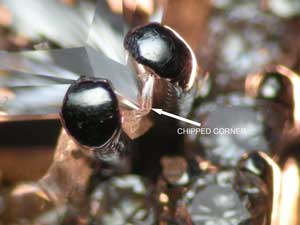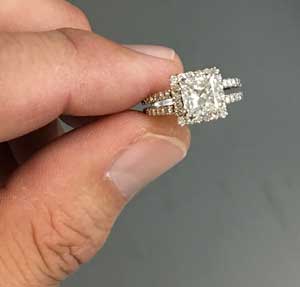Inherent vice / wear-and-tear
losses are rising
 Have trouble getting your bearings in this picture? Try enlarging it. The bulbous black spots are the prongs. An arrow points to a chipped corner. Press here to see more photos. |
Insurers are being set up to pay bogus damage claims. There's a proliferation of damage claims that are actually inherent vice and/or ordinary wear and tear.
Say the insured files a claim. She reports that when she took her ring in to be cleaned, her jeweler told her the diamond was chipped.
It seems to be a simple damage claim. The insurer will probably approve the claim and let the insured's jeweler handle repair or replace. Some insurers will simply write a check. They may even allow the insured to keep the stone rather than taking the salvage.
But wait a minute. Did the jeweler, in effect, just initiate this claim? And did the insurance company, like the insured, merely take the jeweler's word about damage? Do jewelers even know that wear and tear is an excluded peril?
An insurer's standard procedures don't always work.
Let's look at a better approach:
An insurer received a claim for a chipped diamond. The insurer sent the ring to its lab, a lab the company regularly uses for such work, to verify the damage. The photo above gives a view of what the lab gemologist saw, and this is what the lab found:
- Close examination under high magnification showed that all exposed points of the stone were nicked.
- The stone was a princess cut, a shape with four corners that are often cut/polished to have sharp points, which are very vulnerable to chipping.
[Note: Some manufacturers chamfer the corners to make them less vulnerable to damage but that is the exception rather than the rule.]
- Even if the damage is repaired, it will happen again unless the points are protected.
- Damage to the points could have been prevented if V prongs had been used to protect the corners.
- The damage was due to normal wear and tear, an excluded peril, so the insurer was not liable.
- The damage was on the underside of the stone, very minor, and not at all visible or able to be felt while the stone was in its setting.
How did this claim make its way to the insurer?
Since the damage was not seen or felt by the wearer, and could be seen only under great magnification, and even then was barely visible except to a gemologist who was looking for it, how was it noticed in the first place? The answer may lie in the state of jewelry retail today.
In 2016 about 1200 jewelry businesses ceased operation. That's 57% more than in the previous year, and most likely the number of closures continues to increase.
A major reason, no doubt, is that the internet is driving sales margins down, way down! Online jewelry retailers make it easier for customers to buy jewelry on their own, without consulting a jeweler. Following the Amazon model, internet sellers can make up with volume what they sacrifice in per-item prices. And brick & mortar stores, many of which have their own internet sites, are competing for this business.
Meanwhile, buyers are increasingly comfortable with e-commerce. It used to be that an outing to the jewelry store was a major, even a glamorous, undertaking. Today consumers can comparison shop and purchase jewelry from their computer or smart phone without leaving home.
Other conditions eat away at jewelers' income. Lab-grown stones, now more widely available, are lower in price than mined stones, and many consumers are shopping price. Millennials of means are more likely to spend on technology or on experiences, such as travel, than on luxury jewelry. Whatever the reason, jewelry stores are struggling to survive.
With sales and price point declining, one way for a jeweler to increase income and sales is to find a nick or chip in a stone he's cleaned or reset. The jeweler can then encourage the customer to file a claim, with the hope of gaining the repair work and supplying the replacement. The customer trusts her jeweler and files a claim.
Problem #1 is that some of what the jeweler finds is not damage for which the insurer is liable.
- Breakage due to fracture filling
A fracture-filled stone is still fractured and remains vulnerable to breakage and chipping: inherent vice.
- Indented natural
The stone came that way, it did not incur damage.
- Wear and tear
It's common knowledge that diamond is the hardest material on the planet, but it's less understood that diamonds are very brittle.
- Unstable clarity treatments
Cracks or inclusions that were concealed by a clarity treatment reappear when the treatment material fails: inherent vice.
- Unstable color treatments
A stone returns to its original (usually less appealing) color when a color treatment fails: inherent vice.
- A gem shape with vulnerable areas
Sharp corners of princess, pear, marquise, and other cuts are highly susceptible to chipping if they are not protected. Some insurers believe this is inherent vice. Also, an extremely thin girdle is liable to chip.
 If the insurer gets a photo of the jewelry to be insured, it may look something like this. You'll see only the general look of the piece.
If the insurer gets a photo of the jewelry to be insured, it may look something like this. You'll see only the general look of the piece.
You will not get magnified views, like the one at the top revealing the slightly abraded corner. Maybe a stone about to be insured is already damaged, maybe it is fracture-filled or color-treated or has some inherent vice. You, the insurer, know only what is on the appraisal.
Problem #2 happens if the insurer gives the replacement business to the jeweler who found the purported "damage." Chances are the original appraisal valuation was inflated. Chances are the quality of the diamond was also inflated. The jeweler may notice these discrepancies but nevertheless charge the insurer based on the appraisal valuation. The insurer winds up paying inflated costs when there should have been no settlement to begin with.
So: What to do when a damage claim comes in?
For all jewelry claims, regardless of value, always have the jewelry examined by your own expert. This means a disinterested gem lab staffed by qualified gemologists, a lab with which you have an ongoing relationship. The lab should report to you not only existing damage but also characteristics of the stone, gem treatments, or any other conditions that would have made the gem vulnerable to that damage.
The lab should also be able to recognize—and report to you—evidence of wear and tear, which is not damage for which the insurer is liable. Photos like the one at the top, along with explanations of the lab's findings, are extremely helpful to the adjuster.
An alternative is to have the stone removed from the setting and sent to GIA for a report on the damage. GIA is widely regarded as the final arbiter in disputes, and a GIA determination avoids the ill-will of a legal battle.
Either of these choices involves some cost, but that should be regarded simply as part of the loss adjustment expense. These costs will be more than offset by significantly improved loss ratios.
FOR AGENTS & UNDERWRITERS
When taking information for coverage, go about your job as though you are collecting info for a claim. Have that thoroughness in mind, because this is the info the adjuster will need.
Since we know that appraisal valuations are often inflated, ask for the sales receipt (with proof of purchase). If there is a large discrepancy between appraised value and selling price, the price paid is more likely to reflect the jewelry's value.
Appraisal descriptions often inflate gem qualities. The best appraisal includes the JISO 78/79 appraisal form, and is written by a qualified gemologist (GG, FGA+, or equivalent) who has additional insurance appraisal training. One course offering such additional training is the Certified Insurance Appraiser™ (CIA) course of the Jewelry Insurance Appraisal Institute.
Ask the insured for any lab reports. Some labs are known to be unreliable, and some labs are completely bogus; a report from GIA is the most highly regarded. Insureds tend to be very cooperative when taking out insurance, so it is worth the effort to collect necessary documents and multiple pictures of the jewelry (top, side, bottom views) at this time.
FOR ADJUSTERS
Always have damaged jewelry examined by your own expert. Use a gem lab staffed by qualified gemologists who understand the kind of information insurers need. It should be a lab with which you have an ongoing relationship.
Normal wear and tear and inherent vice may look like "damage." Be sure the lab understands distinction that are crucial for insurers.
The lab should report to you not only existing damage but also characteristics of the stone, gem treatments, or any other conditions that would have made the gem vulnerable to that damage. The lab's report should include photos of any damage, with notations.
If you cannot locate a suitable lab, you can submit a diamond to the GIA for a report on damage. The cost of using a lab should be regarded simply as part of the loss adjustment expense and will significantly improve loss ratios.
Have the claim department or the adjuster send the jewelry, along with its documentation, to the lab as soon as the claim comes in. Once you have the lab's report, then involve the adjuster.
Use an adjuster who is well trained and experienced in dealing with jewelry. Caution: "Fixed liability" claims are deceiving. Jewelry losses are not for newbies.
It can be useful to ascertain whether damage was noticed after a ring was left with a jeweler for resizing or for resetting a stone. The stone may have been damaged in resetting, and there have been cases of stones being substituted while in a jeweler's care.
©2000-2025, JCRS Inland Marine Solutions, Inc. All Rights Reserved. www.jcrs.com





